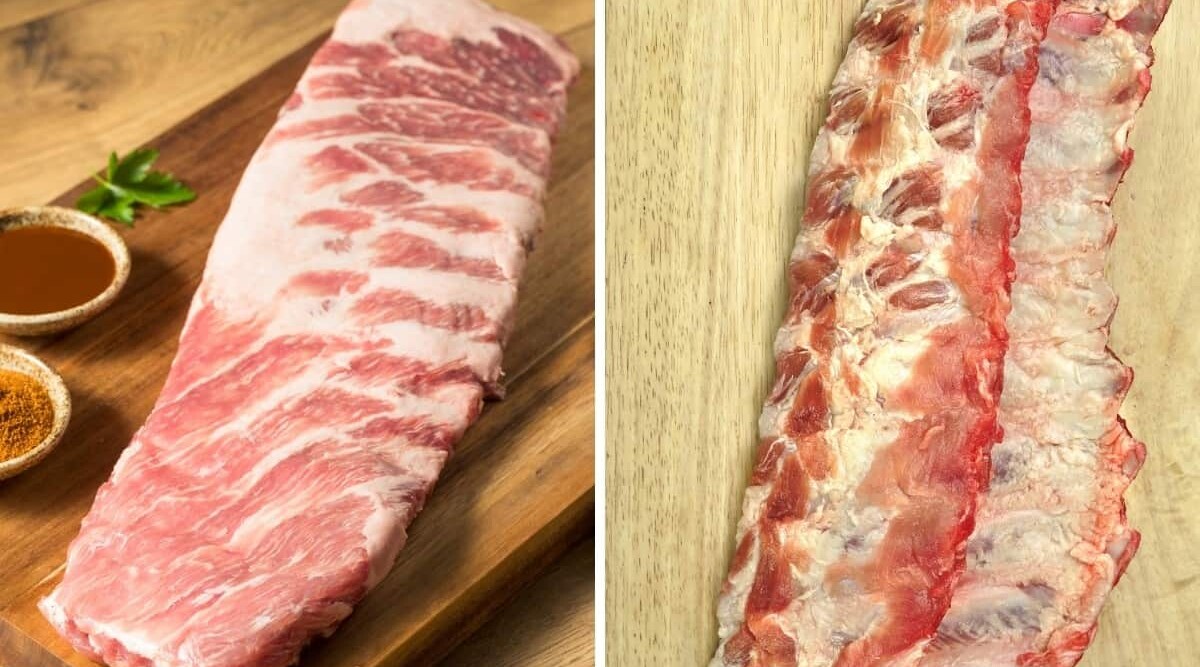
It’s Rib against Rib in this barbecue battle for the ages of baby back ribs vs. St. Louis ribs!
Actually, this is more of a love-in than a battle. Instead of trying to convince you what’s the best choice, like we typically do in our comparison articles, this time, we’re teaching you the differences between these two delicious cuts.
We’ll tell you where they come from on the animal, a little of history, and some comparative nutritional info and stats. Then, we’ll let you know how to prep and smoke each kind, plus share some of the best recipes on the internet for baby back and St. Louis ribs.
All of which should lead, of course, to your own smoked rib showdown! Ready to read about ribs? Let’s start with a handy reference chart.
Jump to:
Comparison Table: St Louis Vs Baby Back Ribs
Here’s a quick overview table showing and comparing the main differences between these two different types of pork ribs.
| Baby Back Ribs | St. Louis Ribs | |
|---|---|---|
| Size | Long rack/short ribs | Short rack/ medium length ribs |
| Meat content | Moderately meaty | Very meaty |
| Fat content | Low fat | Moderate to high fat |
| Average weight (rack) | 1.5–2 pounds | 2.5 – 3.5 pounds |
| Servings per rack | 2 – 3 | 3 – 4 |
| Location on pig | Where ribs join the spine | Bottom of the rib cage at the belly |
We also have two companion articles comparing other styles of ribs that you might be interested in checking out:
St. Louis Style Ribs
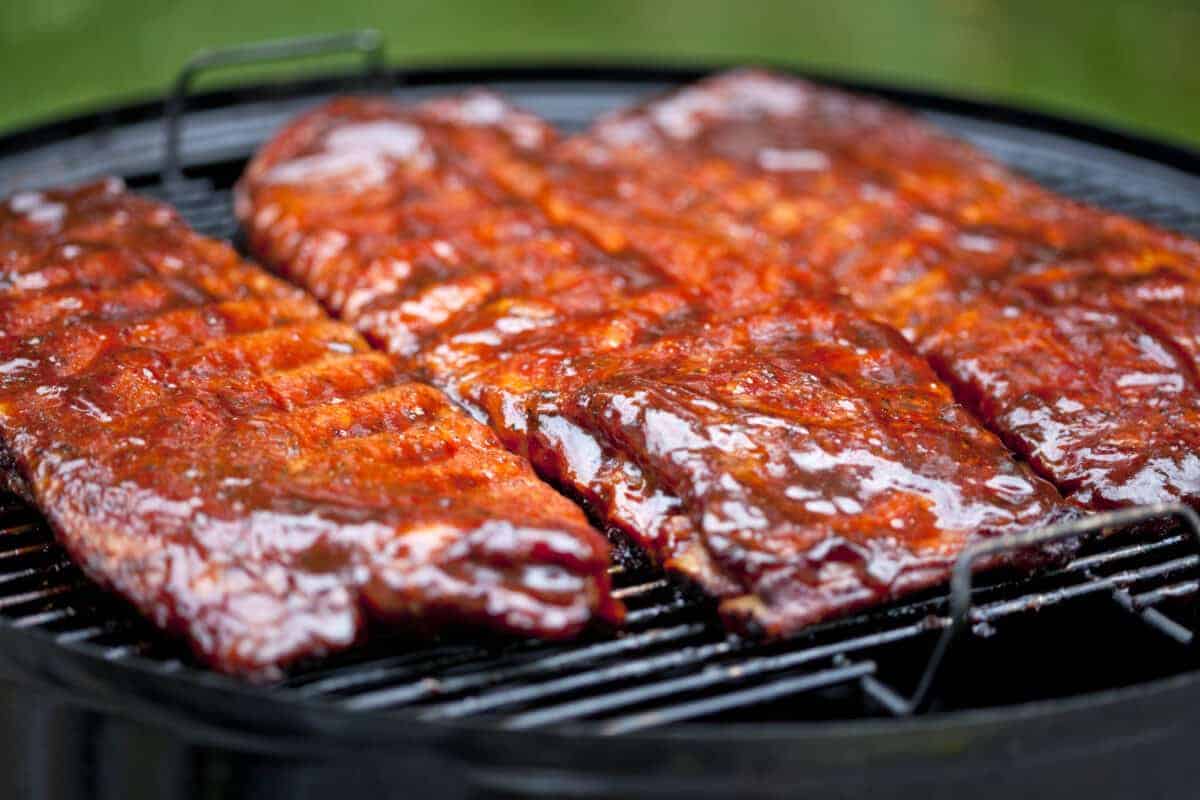
“The St. Louis rib offers the best of two ribs: the lush marbling of baby backs and the meaty richness of spare ribs. It’s easy to cook, tender to the tooth, with flavor that just doesn’t quit.” — Steven Raichlen
Because they’re cut from the larger spare ribs, St. Louis style ribs are sometimes known as St. Louis Spares. The cut originated in the butcher shops of St. Louis, Missouri, in the early to mid-20th century, hence the name; don’t confuse them with Memphis or Kansas City ribs, though. Those are cooking styles for ribs, not cuts.
St. Louis style ribs are big, meaty, and delicious. They aren’t naturally tender, but that’s nothing a good, long, low ‘n’ slow smoke session won’t fix. They’re also not easy to find at the grocery store meat counter, so if you want a rack of St. Louis ribs, you may have to try a local butcher.
Where on the Pig They Come from
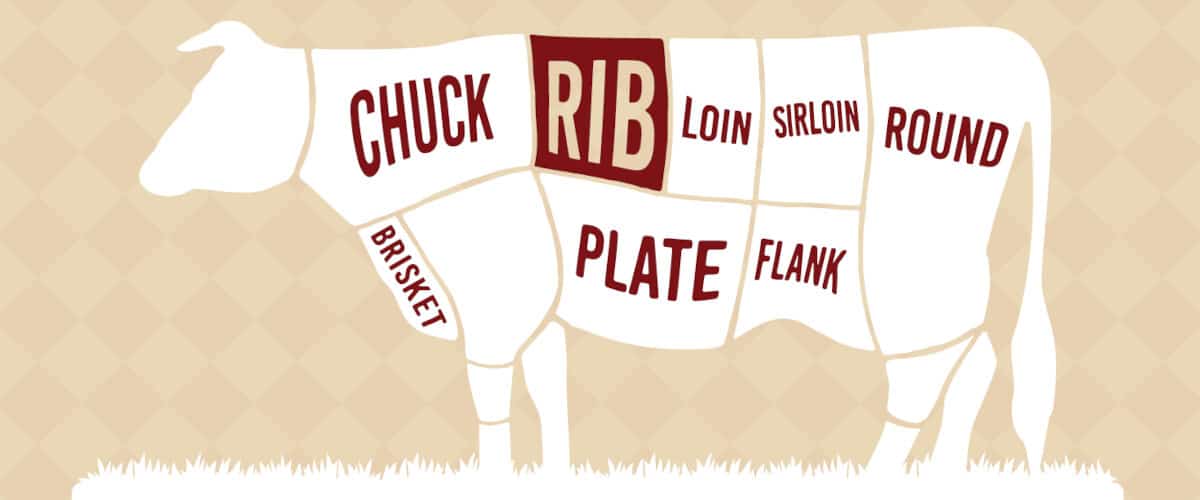
St. Louis ribs are cut from the very bottom of the rib cage, right down in the belly. That’s why they’ve got all that extra meat on them. This is also where spare ribs come from, and, in fact, St. Louis style ribs are spare ribs that have been trimmed to exclude the breastbone and a lot of extra cartilage.
You’ll know them by their medium length, and the flat, rectangular shape of the rack. Expect to find 12 bones in a rack.
How Much Meat and Fat do They Contain?
St. Louis ribs are very meaty, despite the removal of a large flap of meat from the end of the rack. They are also higher in fat content than baby backs, but this just enhances the ribs’ flavor and juiciness after they’re cooked.
Nutritional Information Per 4oz (1/4 Pound)
| Nutrition | Total Amount | % Daily Value (based on 2000 calories/day) |
|---|---|---|
| Calories | 230 | 12 |
| Total Fat | 16 g | 24 |
| Cholesterol | 70 mg | 23 |
| Sodium | 90 mg | 4 |
| Protein | 17 g | |
| Calcium | 0 | |
| Iron | 4 |
Portion Size: How Many St. Louis Ribs Per Person
St. Louis ribs have a lot of meat, and they’re moderately long. A half-rack or about 6 bones is a hearty portion; some diners may need 1 or 2 less.
How to Prepare St. Louis Style Ribs for Smoking
Because they’re already neatly trimmed, you should not need to do any further cutting to get your St. Louis style ribs ready for the smoker.
Your rack may have a thin membrane stretched over the bone side of the rack, however. You’ll want to take this off to make the ribs easier to cut and eat, and to let the smoke and rub access the meat from every angle. We have a full article dedicated to removing the membrane from ribs, but here’s the general gist of it.
If you’re lucky, you’ll be able to just peel it off with your fingers. If you’re not so lucky, grab a paring knife and insert it between one of the outermost ribs and the membrane and start separating them from each other. You may need to make a few short strokes before you’ve got a big enough flap to use as a grab point. Once you’ve got it, carefully rip it from the rack and toss it into the compost.
Now for the flavor! Brining or marinating? Immerse your St. Louis style ribs now and leave them in there for at least a few hours. You want the flavor to penetrate deep into the meat for the best results.
Next, apply your spice rub. Rub it in generously and thoroughly — imagine the best massage you ever had, and then do that to your rack of ribs. With the rub in place, it’s time to put the ribs in your smoker.
How to Cook Them

Now that your ribs are ready for the smoker, here are some quick tips on how to cook them right.
Your ideal smoker temperature is 250 °F. You could go lower, but you’ll probably grow impatient waiting for your ribs to finish. The usual suspects for smoking wood are mesquite, hickory, maple, apple, and cherry. Most recipes specify which wood to use, but these are your best choices if you’re making your own original creation. Oak is ok, too, but it’s better saved for your beef.
If you want to start a debate that never ends, ask a bunch of barbecue chefs whether you should wrap ribs in foil or not when you’re smoking. There are good arguments for both strategies, but we think “yes, wrap them” is the best answer. Wrapping ribs allows them to cook without losing moisture or allowing the flavor to literally leak out.
Although not universally adopted, lots of pitmasters (and regular people) swear by the “3-2-1” method for smoking ribs.
In simplest terms, you smoke your ribs for 3 hours right on the rack, wrap them in foil with some fluid for 2 more hours, and then unwrap them and let them sit naked on the grate again for an additional hour. For the final 60, you turn up the heat a bit and mop on your sauce, if you’re using any. This is when the rib fairies come in and magically create the bark.
When will they be ready? Visually, your cues are exposed bone at the end of the ribs where the contracting meat has pulled back. Give them a poke with your instant-read thermometer — if they’re in the neighborhood of 190 °F – 200 °F, they’re good to go.
Where to Buy St Louis Style Ribs Online
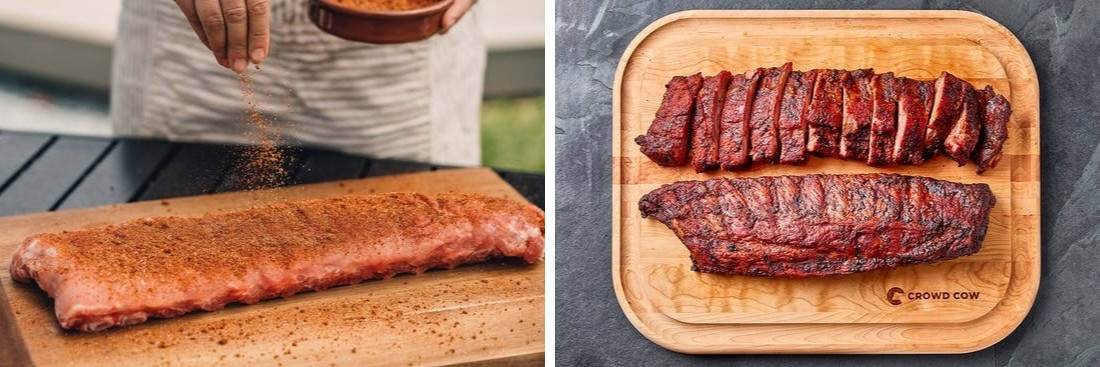
Crowd Cow sells St Louis cut ribs in three different product lines, sourced from three different farmers:
- Heritage breed Berkshire Kurobota from True Story Foods
- All-natural ribs from Pedersons natural farms that are antibiotic- and hormone-free
- Pasture-raised from Gunthorp Farm.
They sell racks weighing 1.5 to 3.5 pounds and even pre-smoked racks that simply need to be defrosted before reheating in the oven for 25 minutes or so.
Three Excellent Smoker Recipes for St. Louis Ribs
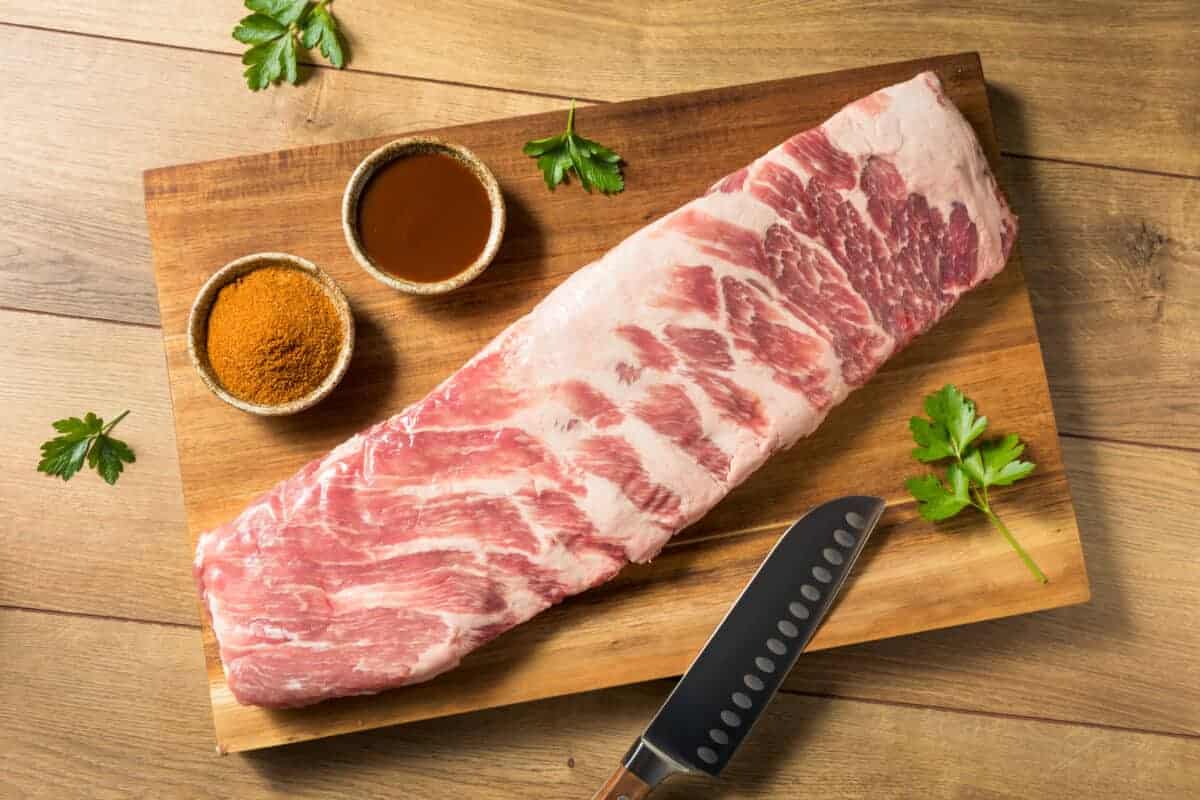
Sometimes it seems there are more recipes for cooking ribs than there are pigs on the planet. To help you out (that’s what we do!), we’ve brought together three of the best from around the digital world.
Southern Smoked Pork Ribs
This classic down home rib captures the taste of authentic southern US barbecue in a simple recipe. A traditional dark brown sugar-based rub gets things started on this flavor journey. The profile is zesty, but without heat — perfect for a mixed crowd and even for kids.
The secret is over 5 hours of smoking. Now that puts the “slow” in low and slow! The recipe is geared towards people who smoke on their grills, but you can just as easily do this in your dedicated smoker. To really amp up the Southern vibes (and flavor), choose hickory as your smoking wood.
For a perfect introduction to smoking your own ribs, this is the link to the Southern smoked pork ribs recipe.
Sweet and Spicy Smoked Pork Ribs
Love your ribs sweet and spicy? Here are both sensations in one succulent recipe. You may need to visit some grocery aisles that are off your usual route to track down Korean chili paste (aka Gochujang), dried mango, and rice vinegar. But other than that, it’s pretty straight-forward.
These ribs have a distinctly Asian flare and we that’s why we love it. After all, it’s one of the older barbecue cultures in the world! True to their name, they are both sweet from fruit and sugar, and spicy from the chili paste and ginger. It’s a match made in heaven, and it’s worth the longer-than-normal prep time.
Ready to expand your horizons? Click here for spicy smoked pork ribs.
Smoky and Spicy Apricot-Glazed Barbecue Ribs
This one is for spice fans, only. Between the jalapeño jam and the chopped chipotles, there’s a notable kick in these ribs. Bring it! The apricots and the fruit wood smoke will complement the heat nicely, without dulling the edge. You’ll be a few minutes creating the sauce, but you’ll have the pride of knowing it didn’t come from a store.
For the perfect bark, have a spray bottle ready to spritz the ribs with apple juice. No spray bottle? Go get one! It’s an essential piece of kit for any serious smoker. These may not be for every crowd, but those who love deep flavor and a tingling tongue will be begging for just one more rib again and again. Oh, and they’d be great with your favorite IPA or amber ale.
To say ‘cheers!’ to great ribs, here’s the recipe for apricot-glazed BBQ ribs.
Baby Back Ribs
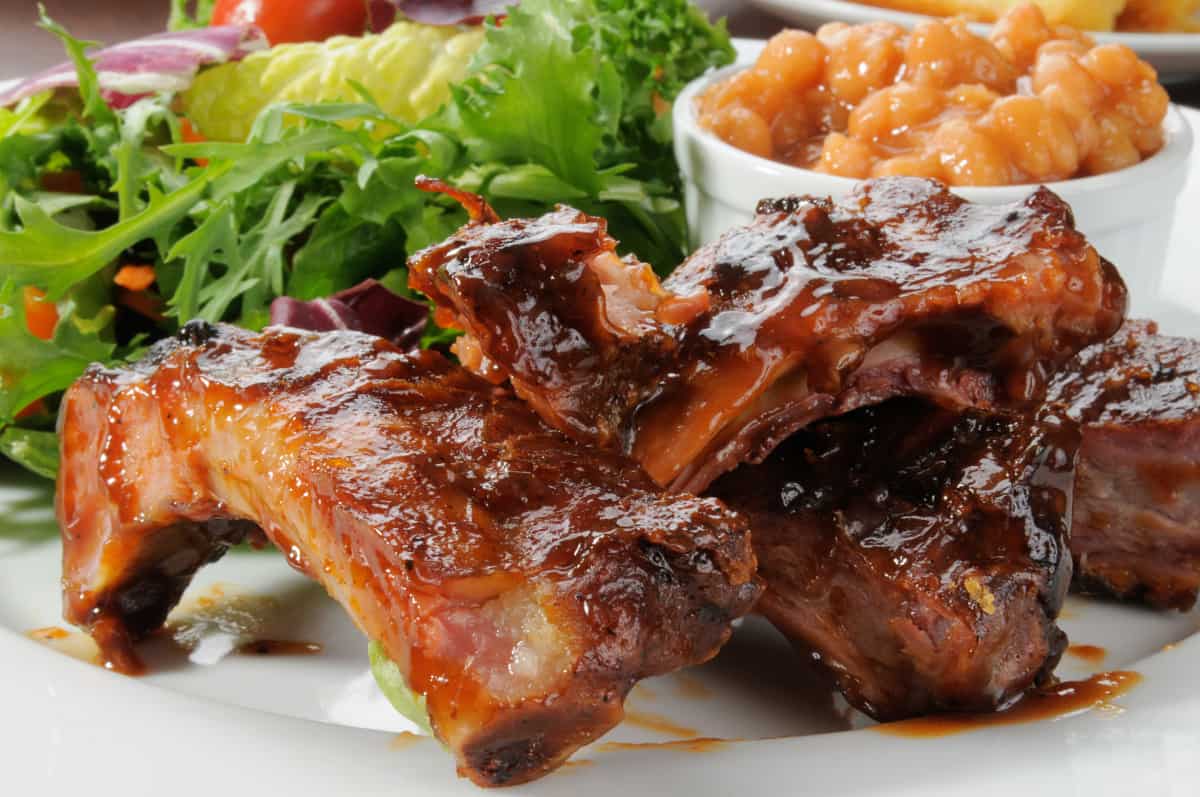
“In Memphis, we tend to prefer the leaner and more tender baby back ribs.”
— Melissa Cookston
Even if you’ve never heard of “baby” back ribs, there’s a good chance you’ve eaten them. Depending on where you live, you may know them as loin ribs, pork loin back ribs, back ribs, or perhaps Canadian back ribs.
You also might have eaten them because many restaurants favor baby back ribs over other cuts. The smaller size makes them plateable, and they cook more quickly than St. Louis ribs, too. Many people appreciate the tender texture, too — and they just look great with their signature curved bones.
Where on the Pig They Come from

You might say baby back ribs are “high on the hog.” They’re cut from the uppermost section of the ribs where they join the spine.
First, the loin is removed, and then the baby back ribs are cut away. This is why they’re sometimes called loin ribs. Baby backs are easily recognized by their short length (both the rack and the individual ribs) and the ribs’ curved shape.
How Much Meat and Fat do They Contain?
Baby back ribs tend to be of moderate meatiness, though you’ll sometimes see a rack with as much meat as a set of spares. They’re low in fat content (for pork), but they’re typically very tender, more tender, in fact, than St. Louis style.
Nutritional Information Per 4oz (1/4 Pound)
| Nutrition | Total Amount | % Daily Value (based on 2000 calories/day) |
|---|---|---|
| Calories | 314 | |
| Total Fat | 21.4 g | 28% |
| Cholesterol | 83 mg | 27% |
| Sodium | 251 mg | 10% |
| Protein | 21 g | |
| Calcium | 51 mg | 3.8% |
| Iron | 1mg | 6% |
Portion Size: How Many Baby Back Ribs Per Person
Since they’re small, you can serve a few more per diner than you might with St. Louis. Plan for plating about 6 or 7 ribs per grown-up. That’s about a half-pound of ribs. They’re fun to nibble, though, so don’t be too surprised if you still want more!
How to Prepare Baby Back Ribs for Smoking
Essentially, you do exactly what’s described above for prepping your St. Louis style ribs. There may be a few extra bits to trim away relative to St Louis ribs, which are generally cut clean by the butcher.
How to Cook Them
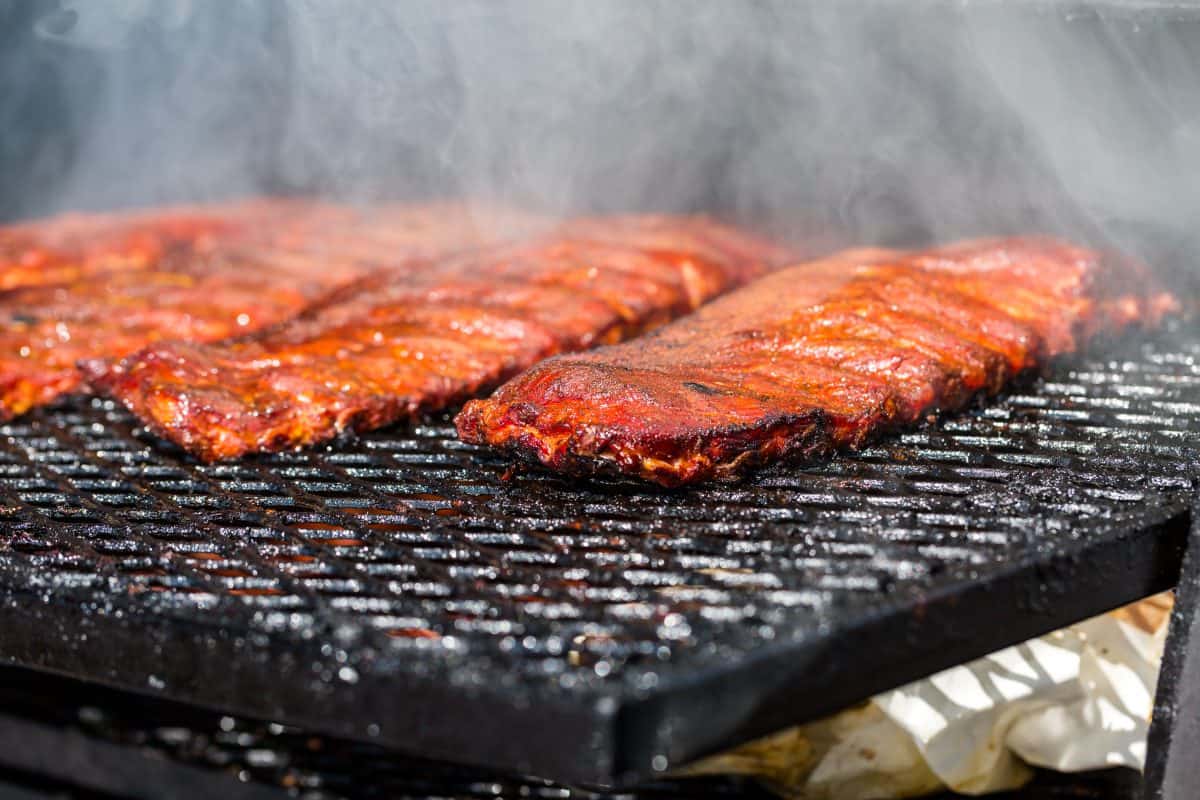
Ready to get ribbing? Here’s the lowdown on smoking baby backs to perfection.
Set your smoker to 225F. That’s the low-end for low ‘n’ slow, but it works well for baby backs, which cook faster than St. Louis style ribs. It also leaves room for fluctuations without getting too hot.
Choose the wood that best suits your recipe. For Southern-style smoking, go with hickory or mesquite. Like your ribs on the sweet side? Apple, cherry, and pecan should be at the top of your list.
One of the age-old arguments when it comes to smoking, is whether or not to wrap your ribs. The majority of pro pitmasters do wrap their ribs. Creating that foil envelope helps lock in the moisture and flavor when the smoke session goes long.
Wrapping is an integral part of the famous 3 2 1 baby back ribs style of cooking: 3 hours unwrapped in the smoker, 2 hours wrapped, and 1 hour unwrapped at an increased temperature. During that last hour is when you mop on your sauce if you’re using any, and let it cook down.
For baby backs, which typically cook quickly because of their size, many people favor the 2-1-1 variation. Just reduce the first two segments by an hour each, and reducing the chances of eating dried up, overcooked ribs. You might even go with a 2-1-0.5 for a quick finish and saucier ribs.
Where to Buy Baby Back Ribs Online
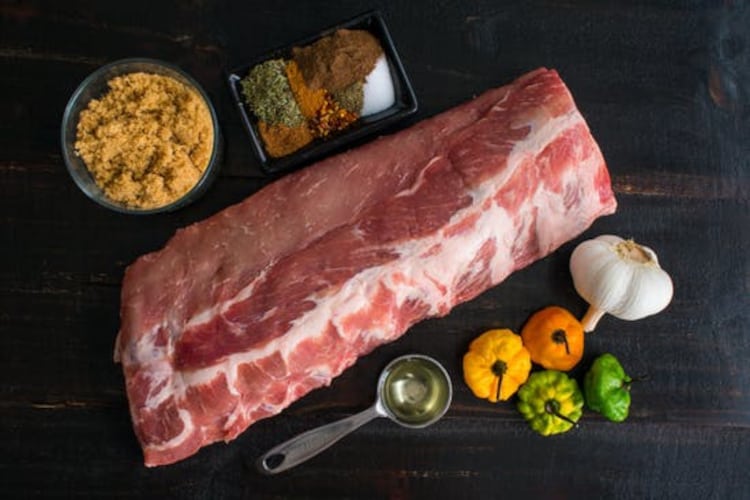
The baby back ribs from Crowd Cow come from Pederson’s Natural Farms, are all-natural and free from antibiotics and hormones.
Each rack weighs on average 1.5 lb, and they are generously meaty and very tender.
Three Excellent Smoker Recipes for Baby Back Ribs from Around the Web
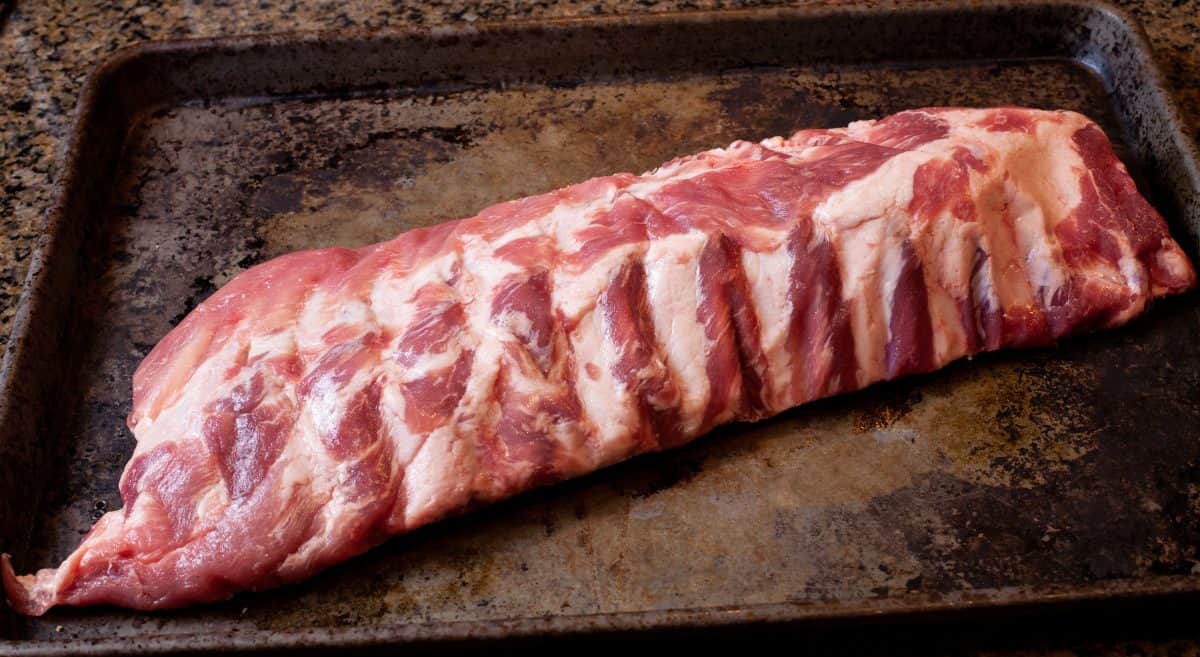
Now for the hard part: choosing how you want to cook your baby backs! To keep your brain from shutting down from option overload, we’ve gathered together three fantastic recipes to get you started.
Smoked Ribs With the Best Glaze
We know what you’re thinking: that better be an awful darn good glaze to earn that name! Well, it ought to be; it’s a classic sweet and sticky glaze made using both ketchup and mustard, plus a dash of maple syrup. You get to mix up your own rub, too, and really show off your culinary skills.
There’s a bit of a spicy kick to the rub, but we wouldn’t call this a challenging plate of ribs. It’s going to be intensely flavorful, though, and you’ll be licking that glaze off your fingers. Don’t forget the apple juice spritz to keep it moist and make that rub stick. Now, settle in for a long, 6-hour smoke session.
Don’t take our word for it — make it yourself and decide if it’s the “Best Glaze” or not. Click here for the smoked ribs with best glaze recipe.
Smoked Bourbon BBQ Baby Back Ribs
Let’s just say you had us at smoked. And bourbon. And again at BBQ Baby Back Ribs. Blending those three elements sounds like rib heaven! What we like about this recipe (aside from the smoking and the bourbon) is how simple it is. You use store-bought rub and sauce, but you still get to mix in a few extra ingredients to get a taste of “from scratch” rib smoking.
How sweet or spicy these ribs are depends on the rub and sauce you choose. You will sweeten things up a bit with some honey and brown sugar, but the rest is up to you. Adjust to suit your tastes and the crowd you’re serving. This is a great “introductory” rib recipe that’s sure to yield exceptional results.
Here’s the full recipe for you to “pour over” – Smoked bourbon ribs.
Spicy Smoked Ribs With Pineapple Rum Glaze
Ah, booze and barbecue. Why do you go so well together? This hugely flavorful recipe brings the best of the tropics to your smoker for a spiced up rack with a unique glaze you might want to paint on just about everything you cook. The rub will have you emptying your spice cabinet looking for everything from ground coriander to allspice.
We love the blend of Jamaican rum and pineapple juice in the glaze and the hit of hot sauce in the rib sauce. If you like your ribs to be an epic flavor adventure, you won’t mind the extra prep time required for this extra special recipe.
Have you got what it takes to make these ribs? (Or will you need to go to the store, first?) Find out by clicking this link to the recipe.
Ever Considered Cooking Beef Ribs?
This article has taken a deep dive look at two of the most popular cuts of pork ribs, but have you ever considered beef ribs? We have a few articles you can chew over to get familiar with them.
Start with a look at the difference between pork ribs and beef ribs, then a good overview of the handful of different types of beef rib cuts, before ending with a look at my smoked beef rib recipe.
Trust me, you’ll love them!
Final Thoughts
Two kinds of ribs, six recipes; have you chosen your combo yet? You really can’t go wrong no matter which way you go. The end results will be the same — delicious ribs for you and the lucky people you share your table with.
If you have any questions for us, send them along, and we’ll answer them ASAP, so you can get back to your ribs. We welcome your comments, too, and any great tales from the backyard you’d like to share. Be sure to follow us on social for even more content and interaction with fellow grillers. And, as always, we invite you to share this article and any others you enjoy with your friends and family.
Thanks for reading and enjoy the ribs.


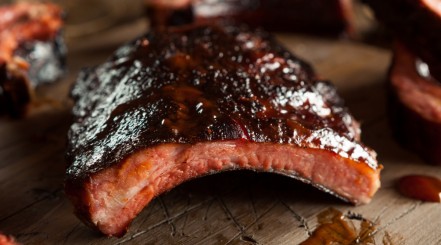
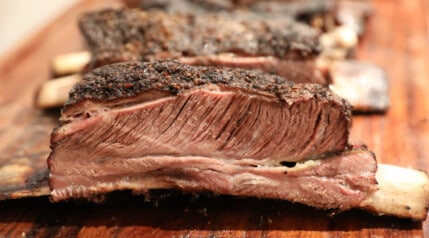
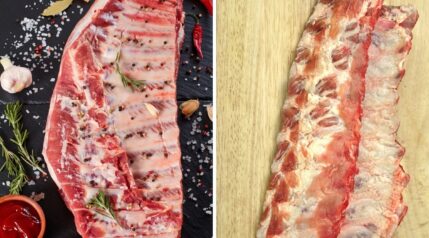
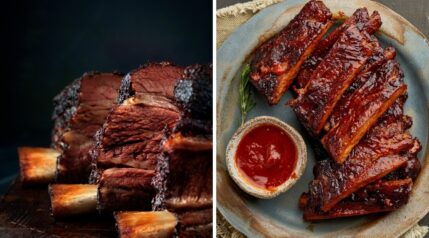
Thanks Jim!!! A ton of info, plus some!!! You read my mind when you added beef ribs at the end!!! Thanks man!!!